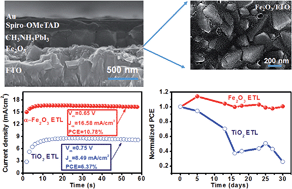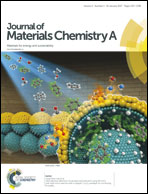Hematite electron-transporting layers for environmentally stable planar perovskite solar cells with enhanced energy conversion and lower hysteresis†
Abstract
Non-obvious hysteresis and higher steady-state power conversion efficiency (PCE) were demonstrated by simply employing hematite (α-Fe2O3) as the electron transporting layer (ETL) to replace the conventional titania (TiO2) ETL in planar heterojunction perovskite solar cells. The achieved higher built-in potential across the perovskite layer for the devices using α-Fe2O3 ETLs led to more efficient charge extraction/transport and less charge recombination than using TiO2 ETLs. As a consequence, a significant reduction in the charge accumulation at the perovskite/α-Fe2O3 interface made the device much less sensitive to the scanning rate and direction, i.e., lower hysteresis. Furthermore, α-Fe2O3 based devices displayed good stability over 30 days of storage time with exposure to ambient air, owing to the higher crystalline quality and uniform grain size of the perovskite films deposited on α-Fe2O3 ETLs than on TiO2 ETLs.



 Please wait while we load your content...
Please wait while we load your content...